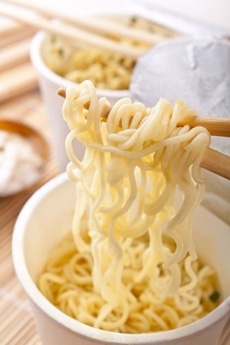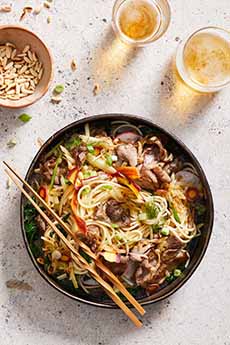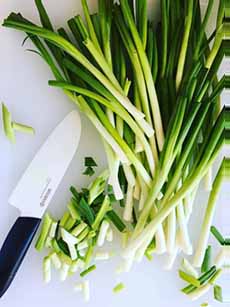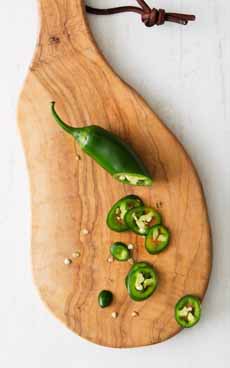|
Ramen is a Japanese noodle soup made with Chinese-style wheat noodles (Chinese-style noodles are egg noodles), served in a meat or fish-based broth. In Japan, it’s all about the broth: rich, slow-simmered, beautifully-seasoned broth, often made with pork bone. And noodles: Ramen is a noodle soup. The noodles are always long wheat noodles, but can vary in their shape (straight vs. wavy, round, squared, or flat) and their thickness. There’s a myriad of toppings from sliced pork, scallions, leeks, soft-boiled eggs, mushrooms, nori (dried seaweed), menma (fermented bamboo shoots), and scallions.
Ramen dishes are fine cuisine, and innovation is the name of the game. Ramen recipes are closely guarded secrets. In the U.S., Japanese chefs buy quality dried ramen (not with grocery-store ramen and their packets of seasoning).
Check out the ramen recipes below.
STYLES OF RAMEN
Ramen broth can be made with beef, chicken, fish, or other seafood or pork. How the broth is seasoned is largely influenced by the base protein.
Each region of Japan puts its own spin on ramen. Here are some of the styles:
Karē (curry) ramen was developed in Hokkaido during the second half of the 1900s. Curry paste delivers a different type of spice experience. The broth can be clear (as in (shio or shoyu) or opaque and milky (as in tonkotsu).
Miso ramen emerged in Hokkaido, Japan in the 1960s—the newest of the ramen broths. Made with miso paste, the broth is nutty and features curly, chewy noodles. In a break from tradition, it can contain sweet corn and creamy butter [source].
Shio, meaning salt, is considered the oldest of the ramen broth styles (sea salt is considered the oldest form of ramen seasoning). It’s made with a chicken or fish bones, and sometimes, pork bones. The broth is clear yellow. Recipes contain vegetables, and often, seaweed.
Shoyu ramen features wavy noodles in a shoyu broth* flavored with fish stock (photo #1). Soy sauce is added to a pot of chicken, vegetables, and water, and simmered into a light brown broth.
Tonkotsu (not tonkatsu) is made with pork hock and trotters. The collagen in the bones and tendons makes the broth dense and slightly sticky. Together with fat, it turns the broth milky and cloudy white [source].
Tsukemen has a thicker and more robust broth, but serves the noodles “on the side.” You pick the noodles up with your chopsticks, and dip them in the broth.
Do instant ramen noodles belong shoulder-to-shoulder with these five varieties? We think not: They’re fast food, full of additives and not good for you.
INSTANT RAMEN: GIVING A BAD RAP TO RAMEN SOUP
In the U.S., most of the ramen consumed comprises packaged ramen noodle soups. Known best as inexpensive fare for college students, there’s nothing inherently wrong with them. The hot, chewy noodles can provide almost as much comfort as a hug from mom. It’s a deal of a meal.
The bad rap of packaged ramen soup comes from the spice packet used to flavor the broth. What’s so bad about it? More often than not, beyond the dried soup ingredients, it includes an unconscionable amount of sodium, a cocktail of unpronounceable ingredients, and a kick of MSG. Yikes.
So consider making homemade ramen soup with The next time you come across a package of ramen soup, take it home, ditch the shady silver spice pack and improvise. There is no end to what you can add to the broth, so get creative and turn your ramen into “fine cuisine.”
> The history of ramen noodles.
WAYS TO ENHANCE A BOWL OF RAMEN NOODLES
Use broth. Start by using chicken or vegetable broth in place of the water used to cook the noodles. This simple step takes you from boiled noodles to noodle soup. With vegetable broth, a tablespoon of roasted garlic is a great flavor booster. With chicken broth, a squeeze of lemon, and some rough-chopped, fresh herbs (like parsley, thyme or cilantro) add a touch of brightness.
Add a drop of oil. A few drops of sesame oil add depth and earthiness. Prefer heat? Add a couple of drops of chile oil or mustard oil.
Add bacon. Dice some bacon or pancetta (you only need a couple of ounces), sauté it to crispness, and add it to the broth to give your ramen the hearty flavor that only pork delivers. If you don’t have a cholesterol issue, add a spoonful of the bacon fat to the pot. You’ll be surprised how much it can add to the flavor and mouthfeel of the broth.
Add onion. Caramelize half a julienned onion, then deglaze the pan with beef stock. Bring the liquid to a simmer, then use it to cook the noodles. You’ll get a rich, French onion soup flavor.
Add veggies. What’s in the produce drawer? Dice and slice the veggies, boil or steam in the microwave and add them to the soup.
Use garnishes. Fresh chives or scallions, sliced jalapeño, a chiffonade of basil: Whatever you’ve got, use it to create “ramen cuisine.”
How about a little Ramen Carbonara? Render a quarter pound of diced pancetta in a pan. Cook the ramen according to the package instructions, using boiling water with half a teaspoon of salt stirred in. When the ramen is cooked, add it to the pancetta with the pan on medium heat, and add one uncooked scrambled egg.
> It’s important to stir constantly once the egg is in the pan, as this will allow it to coat the noodles rather than turn them into scrambled eggs.
> Finish with some grated Parmesan cheese and coarsely ground black pepper. And even though this sounds like dinner, it is more or less bacon and eggs, so feel free to eat it for breakfast.
Plan B For Instant Ramen Soup: Ditch The Seasoning, Keep The Noodles
You don’t need that packet of salt. Substitute another broth (e.g. Swanson Low-Sodium Chicken Broth), or free to eliminate the broth altogether and use the noodles on a salad or other recipe.
After all, ramen is simply pre-cooked egg noodles.
RAMEN SOUP RECIPES
10-Minute Homemade Ramen Soup
Homemade Ramen Soup
Homemade Pork Ramen Soup
Modern Ramen Toppings
FOOD 101: TYPES OF PASTA
Ramen is one of the many types of pasta made worldwide. Check out our Pasta Glossary for photos of many types of pasta.
RAMEN IN JAPAN PRE- AND POST- WORLD WAR II
________________
*Shoyu broth has a soy sauce base (shoyu is Japanese for soy sauce) with a clear, brown color. Meat or vegetable stock is added, to give it a delicious, tangy flavor. Usually, shoyu ramen is served with curly noodles.
|
|

[1] Turn instant ramen noodles into something special. Why are these ramen curly? Because one creative idea is to substitute different pasta shapes—here, fusilli (photo © Olga Nayashkova | Fotolia).

[2] Garnish your ramen with just about anything: boiled or poached eggs, fish, meat, tofu/tempeh, vegetables galore, herbs, nuts, you-name-it (photo © Lightlife).

[3] Ramen with shrimp, baby bok choy, sugar snap peas, scallions, red bell pepper, microgreens, chili paste and chile flakes (photos #3 and #4 © DeLallo).

[4] Ramen with an Italian twist: porchetta, radish, scallions, dill, and pine nuts.

[5] Every bowl of ramen needs a garnishing of scallions (photo © Kyocera Cutlery | Facebook).

[6] Want more heat? Add jalapeños (photo © Good Eggs).
|





